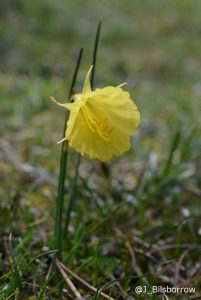By Jordan Bilsborrow and Kálmán Könyves

Daffodils are very popular garden plants and an important commercial crop both as bulbs and as cut flowers. Our fascination with these very charming spring flowers has led to many cultural links in literature and art (reviewed in Hanks 2002) and there is evidence that these plants have been in cultivation for many centuries.
Last year’s advent botany blogs featured Paperwhites (Narcissus papyraceus), a common daffodil available over the festive period. Paperwhites have to be specially prepared by artificial chilling to get them to flower for Christmas. This year we focus upon their less known, miniature cousins, hoop-petticoat daffodils which flower naturally through the winter season. This makes them an ideal Yuletide flower although they have not gained quite the popularity of the Christmas Rose, Winter Jasmine or other winter flowering garden plants common in British gardens, perhaps due to the preference for mild winters.
Narcissus section Bulbocodii are clearly distinguished from other daffodils by their large showy corona and rather reduced petals. Generally there are five species recognised in the wild; however two of these, N. romieuxii and N. cantabricus, are difficult to separate (Könyves 2014). They have a wide distribution ranging from southern France, throughout the Iberian Peninsula, to southern Morocco, and western Algeria. Taxonomically this group is problematic due to the abundant morphological variation, often within the same population, and prevalent hybridisation.
In cultivation there are over 170 registered hoop-petticoat daffodil cultivars (Daffseek 2016), which are only a very small proportion of the total 30,000+ registered daffodil cultivars. All this makes studying hoop-petticoat daffodils both challenging and fascinating at the same time.

We have both been fortunate enough to see these beautiful plants in Spain and Morocco during our PhD research. A report of this research, and particularly the field work, has been published in the Daffodil, Tulip and Snowdrop Yearbook article we wrote about Moroccan daffodil hunting.
Daffodil bulbs are often forced to flower early to be sold as cut flowers, but most of the species are naturally spring flowering in the wild. Here in the UK in particular, daffodils are one of the early indications of spring having arrived. However, when the weather is mild, hoop-petticoat daffodils can be seen flowering throughout December or even earlier. These miniature daffodils can usually be found in the gardens of true daffodil enthusiasts or alpine gardeners. Hoop-petticoat daffodils are hardy and will cope well with our winters and can brighten lawns with white and yellow flowers during winter and early spring. The flowers can last for several weeks, providing much-needed colour to the garden over winter. This characteristic, as well as their rather interesting, showy and beautiful flowers could make them a nice alternative to the Paperwhites for the festive period.

Jordan Bilsborrow is currently a PhD Student studying the systematics of Narcissus.
Kálmán Könyves is a botanist at The Royal Horticultural Society and was previously a PhD Student studying the systematics of Narcissus.
References
Konyves, K., David, J. and Culham, A. (2011) Towards a reproducible system of identification for daffodil cultivars. In: Bradbury, M. S., Akers, W. M., Akers, J. l., Blanchard, J. W., Brickell, C. D., Duncan, B. S., Gibson, J., Hanks, G., Kington, S. and Lady Skelmersdale, (eds.) Daffodil, Snowdrop and Tulip Yearbook. The Royal Horticultural Society, London, pp. 26-29. ISBN 9781907057229
